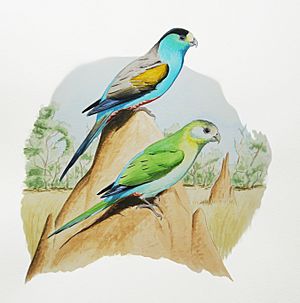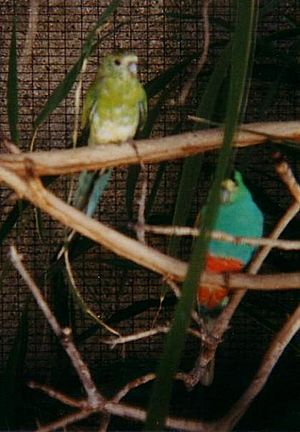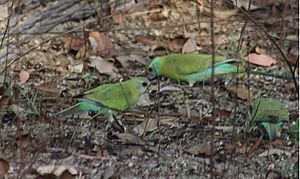Golden-shouldered parrot facts for kids
Quick facts for kids Golden-shouldered parrot |
|
|---|---|
 |
|
| Male and female | |
| Conservation status | |
| Scientific classification | |
| Genus: |
Psephotellus
|
| Species: |
chrysopterygius
|
| Synonyms | |
|
Psephotus chrysopterygius |
|
The golden-shouldered parrot (Psephotellus chrysopterygius), also known as the alwal, is a rare and beautiful bird. It lives in the southern part of Cape York Peninsula in Queensland, Australia. This small parrot is related to the more common red-rumped parrot. It is also closely related to the hooded parrot and the paradise parrot, which is now extinct.
Contents
What the Golden-shouldered Parrot Looks Like
The golden-shouldered parrot is about 23 to 28 centimeters (9-11 inches) long. It weighs around 54 to 56 grams (about 2 ounces).
Male Parrots
Adult male parrots are mostly blue. They have a bright yellow patch on their shoulders. They also have a black cap on their head and a pale yellow band across their forehead. Their lower belly, thighs, and the feathers under their tail are a dark salmon pink. The lower part of their back is grey-brown.
Female Parrots
Adult female parrots are mostly a dull greenish-yellow color. They have a wide cream-colored stripe on the underside of their wings. Older females have a charcoal grey cap on their heads. The feathers near their vent area are a pale salmon pink.
Young Parrots
Young parrots look similar to adult females. However, newly fledged young males have a brighter blue patch on their cheeks than females of the same age.
Where Golden-shouldered Parrots Live
The golden-shouldered parrot lives in open grasslands with many trees. These areas often have lots of termite mounds. Sometimes, these mounds are only a few meters apart.
What They Eat
These parrots eat the seeds of small grass species. For several months of the year, especially before the wet season, they mostly eat the small but plentiful seeds of firegrass (Schizachyrium fragile).
Their Homes in Termite Mounds
An important part of their habitat is the presence of suitable termite mounds. These mounds are where the birds build their nests. Because of this, the golden-shouldered parrot and its relatives are sometimes called "antbed parrots."
Reproduction and Life Cycle
Golden-shouldered parrots build their nests inside termite mounds. They prefer the lower, dome-shaped mounds. This might be because these smaller, denser mounds heat up and cool down more slowly.
Building Nests
They usually dig a burrow into the mound when the wet season rains have softened the mound's material. The tunnel is typically 50 to 350 millimeters (2-14 inches) long. It goes down into the mound and ends in a nesting chamber.
Eggs and Chicks
A female parrot lays between 3 and 6 eggs. The eggs are incubated for about 20 days. The termites inside the mound help to control the temperature. This natural "air conditioning" keeps the parrot's nest chamber at around 28-30 degrees Celsius (82-86 degrees Fahrenheit). Because of these stable temperatures, the parrots sometimes leave their eggs at night, starting about 10 days after the chicks hatch.
Helpful Moths
An interesting relationship exists between the golden-shouldered parrot and a type of moth called Trisyntopa scatophaga. These moths are found in about half of parrot nests. The moths find newly dug nest tunnels and lay their eggs near the entrance. When the moth larvae hatch, they eat the droppings of the baby parrots. This helps to keep the nest chamber clean.
Survival Rates
It seems that more male parrots are born than females. This might be because male parrots face more dangers in the wild. If an adult male parrot is lost, a young male parrot might take over its role. This young male might even help feed the chicks of the deceased male. This behavior might be a way for the parrots to adapt to the higher rate of predation on adult males.
Status and Conservation Efforts
The golden-shouldered parrot is listed as an endangered species. Recent surveys suggest there are about 2,000 birds in the wild. Around 300 of these are breeding pairs. Most of the remaining birds are young birds in their first year of life.
Threats to the Parrots
This species lives in a small area and faces several threats:
- Predators: Feral cats and pied butcherbirds hunt the parrots. Feral pigs also disturb and dig out nests.
- Habitat Changes: The biggest threat comes from changes to traditional Aboriginal burning practices in the grasslands.
- Wildfires: Large, uncontrolled wildfires destroy all the seeds the birds depend on. They also allow "teatree" plants to grow thickly in the grasslands. These thickets provide cover for predators like the pied butcherbird, making it easier for them to catch parrots, especially young ones and adult males.
Conservation Work
BirdLife International has identified important areas for golden-shouldered parrot conservation. These include the Morehead River and Staaten River.
The owners of Artemis Station have also been doing important conservation work since the 1970s. They have brought back traditional burning practices. They also temporarily move cattle away from prime breeding sites. Recently, they have set up feeding stations to help young birds survive the difficult first months of the wet season. During this time, heavy rains can wash away or drown any remaining seeds. This often causes many young birds to die before new grass can grow. These conservation efforts seem to be helping to stop the population decline, but the numbers are not increasing yet.
Parrots in Captivity
The golden-shouldered parrot is rare in captivity. There are about 1,000 birds in Australia and around 300 in aviaries overseas. This means there is a limited number of birds available for breeding programs. Dedicated breeders in Australia and other countries are working to keep a healthy breeding population in captivity. They are trying to create successful breeding conditions by using heated nest boxes and feeding the birds a diet similar to what they eat in the wild. It is important to keep only one pair of parrots per aviary and to have solid walls between aviaries to prevent fighting. Providing aviaries with earth floors is also considered best practice, as it allows the parrots to dig and feed on the ground, just like they do in the wild.
Images for kids
See also
 In Spanish: Perico aligualdo para niños
In Spanish: Perico aligualdo para niños






